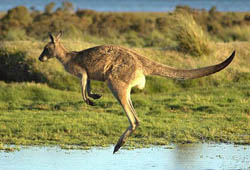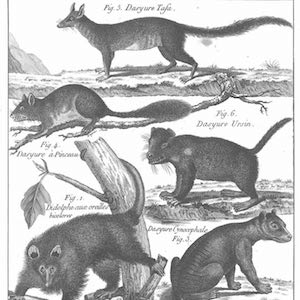
Jumping Genes of the Kangaroo
show/hide words to know
Century: a period of 100 years.
Data: the results (values) obtained in a scientific experiment, or investigation. Note that "data" is the plural form of the word "datum." Example - the data are shown in this graph... more
Fossil: the hardened remains, or an impression of remains of an organism that existed in a past geological age... more
Gene: a region of DNA that instructs the cell on how to build protein(s). As a human, you usually get a set of instructions from your mom and another set from your dad... more
Genome: all of the genetic information of an organism (living thing)... more
Kin: family, a relative like your mother, father, or sister and brother.
Marsupial: a mammal that has babies born very early in their development that are usually carried and fed in a pouch on the mother's belly... more
Retroposon: \"jumping genes\" that are inserted into the genome at random.
What's in the Story?

Kangaroos live in Australia, but may have relatives as far away as South America. Wikimedia Commons - pan bk
Marsupials such as the kangaroos, Tasmanian devils, and wallabies are just a few examples of important wildlife that live on the continent of Australia. However, they may not have always lived in Australia. In the PLOS Biology article, "Tracking Marsupial Evolution Using Archaic Genomic Retroposon Insertions," scientists look at new information that suggests marsupials came to Australia all the way from South America.
Kangaroo Kin
Marsupials like kangaroos are a special type of mammal. Mother marsupials have a pouch for their babies to live in after they are born. Their babies stay in this pouch until they can survive on their own.
Something that really interests scientists about marsupials is how different species in South America and Australia are related. At the moment, little is actually known about where kangaroos originally came from, because it is often very difficult to find fossils of ancient marsupials to study and compare.
Although there are not solid answers as to how different marsupials are related, there are many scientists that are working to solve the puzzle. One of the ways that scientists can find out how species are related is by studying the animals’ genes.
A gene is a portion of DNA that has instructions that can be passed on from generation to generation and that gives animals important characteristics such as shape, eye color, or foot size. All of the genes of an animal is called its genome. Scientists study the genomes of different animals and compare similarities and differences to determine how some animals are related to others.
Jumping Genes of the Kangaroo
Scientists in Germany looked at special types of genes known as retroposons, or “jumping genes” to compare marsupials in Australia and South America. Jumping genes get their name because unlike regular genes, retroposons can "jump" around or be inserted into the genome during replication in random patterns. The patterns created by the jumping genes then get passed on to new generations. Because the “jumping gene” insertions are random, when many retroposons match between species, it is an excellent sign that the animals are probably related.
Scientists created the image on the right to show how the "jumping genes" of two different marsupials can be very similar. The colored ovals show how the genes between two species are alike. In the left column are genes of an opossum from South America, and the right column shows the genes of an Australian kangroo. Look back and forth between the columns line by line, and you will see how similar these genes are between the two different marsupials. This shows that even though South America and Australia are very far apart, the marsupials that live on these continents are closely related.
The scientists looked at the genes from more than just opposums and kangaroos. They examined twenty different marsupial species. After all their analysis, the genes in Australian marsupials were traced all the way back to South America.
The image on the right shows how scientists figured out the way that marsupials species are related. The oldest species of marsupial are opposums, located at the very top of the image. As you work your way down the image, each species evolved more recently than the last. Australian kangaroos are at the bottom and are therefore the most recent species to evolve. Marsupials that are connected by a gray line are from South America, while marsupials connected by a black line are from Australia.
Before this study, scientists used to think marsupials came from Australia. This new data is an interesting find in a field where there is still much to be understood. The scientists believe that “jumping genes” might continue to unlock answers to important questions in animal evolution and tell us more about how different animals are related or change over time.
Additional images via Wikimedia Commons. Marsupial species plate by M.A.G. Desmarest in 1820.
View Citation
Bibliographic details:
- Article: Jumping Genes of the Kangaroo
- Author(s): Sarah Ly
- Publisher: Arizona State University School of Life Sciences Ask A Biologist
- Site name: ASU - Ask A Biologist
- Date published: September 2, 2011
- Date accessed: April 17, 2024
- Link: https://askabiologist.asu.edu/plosable/jumping-genes-kangaroo
APA Style
Sarah Ly. (2011, September 02). Jumping Genes of the Kangaroo. ASU - Ask A Biologist. Retrieved April 17, 2024 from https://askabiologist.asu.edu/plosable/jumping-genes-kangaroo
Chicago Manual of Style
Sarah Ly. "Jumping Genes of the Kangaroo". ASU - Ask A Biologist. 02 September, 2011. https://askabiologist.asu.edu/plosable/jumping-genes-kangaroo
Sarah Ly. "Jumping Genes of the Kangaroo". ASU - Ask A Biologist. 02 Sep 2011. ASU - Ask A Biologist, Web. 17 Apr 2024. https://askabiologist.asu.edu/plosable/jumping-genes-kangaroo
MLA 2017 Style

Scientists have studied the differences between marsupial species for centuries.
Be Part of
Ask A Biologist
By volunteering, or simply sending us feedback on the site. Scientists, teachers, writers, illustrators, and translators are all important to the program. If you are interested in helping with the website we have a Volunteers page to get the process started.








